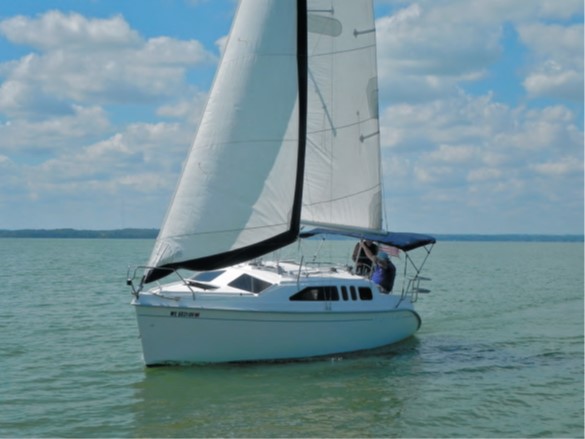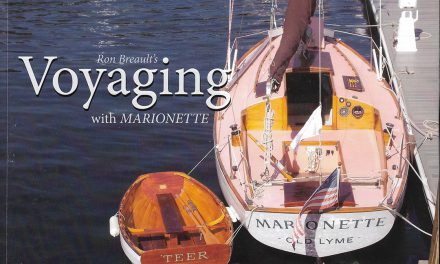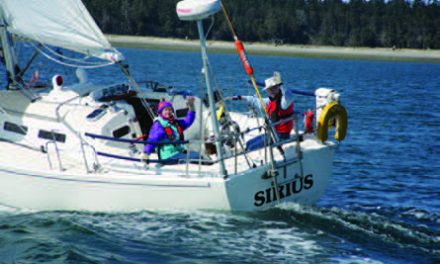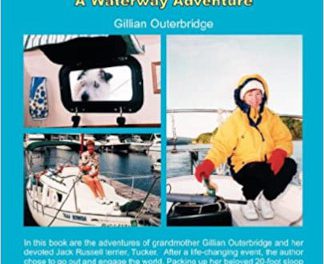A Low-Priced, Water-Ballasted Trailer-Sailer
Issue 142: Jan/Feb 2022
Bill and Marianne Blaschka of Madison, Wisconsin, have been so blown away by the Hunter 260 that they’ve kept theirs for 12 years—and even named it that, Blown Away. Previous boats in their fleet include an O’Day 20, Hobie 16, and Balboa 26—all trailerable.
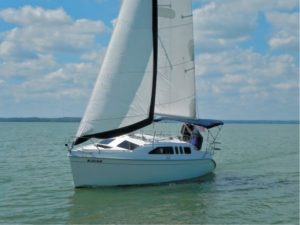
The Hunter 260 looks a bit pudgy due to its 9-foot beam, flush deck, and high freeboard, perhaps creating doubt about her handling and motions, but she sails sweetly.
When Bill retired from the Wisconsin Department of Corrections, he started a day charter business called Sail Madison on Lake Mendota. Bill estimates he’s taken a thousand folks sailing, but has closed the business after 11 incident-free years.
History and Design
Starting in 1969, Warren Luhrs, with his father, Henry, and brother, John, built Henry Luhrs Sea Skiffs and Silverton Sea Skiffs before producing the first John Cherubini-designed Hunter 25 sailboat in 1973. Ninety-four models of Hunters followed.
In 2012, David E. Marlow acquired Hunter, with current boats sold under the Marlow- Hunter name. Hunters have long been known as a good value thanks to efficient production methods and judicious choice of materials.
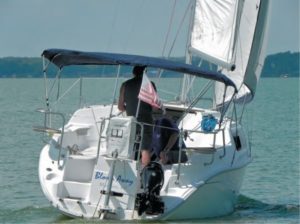
A good look at the transom of a wheel-steered model, above. On tiller-steered boats there is no helm seat and the transom is completely open.
Warren Luhrs set records and won singlehanded ocean races on his Paul Lindenberg-designed Open 60 Thursday’s Child. With this boat he developed innovations such as the swept-back B&R rig and water ballast, both featured on the 260.
The Rob Mazza-designed (yes, Good Old Boat’s technical editor), water-ballasted Hunter 23.5 came along in 1992 at a time when modestly sized trailerable sailboats were having something of a market surge. This trend was led by MacGregor, the low-price leader, which had introduced the water-ballasted 26D in 1986. Santana came out with the water-ballasted 2023 in 1993. All shared the concept of draining water ballast for lighter on-the-road towing (there is also construction savings in water ballast).
The Hunter 26, again a Mazza design, was added to the Hunter lineup in 1994 as a larger version of the 23.5. In 1997, Hunter made several changes to the 26, altering the windows and forehatch, adding the B&R rig, a swim platform, and a new rudder, as well as some minor dimensional changes to length and beam. This became the Hunter 260, so a 1997 model could be either a 26 or 260.
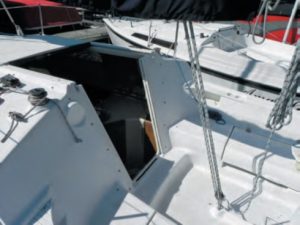
The mainsheet tackle is fastened to the cockpit floor, handy to the helm of a tiller-steered boat, but not so much with a wheel. Not an issue with crew aboard.
Most Hunter 26s had tiller steering, while the Hunter 260 was available with Edson wheel steering as a popular option. With the 260, Hunter began using an innovative interchange-able molded section in the cockpit and transom so they could build the tiller and wheel versions with different transoms without needing different hull molds.
The tiller-steered boats have a wide-open transom down to the small swim platform. On both versions, the outboard is offset to starboard. Key features of the 26/260 are the retractable, lightly weighted centerboard and rudder that allow for skinny-water anchoring and beaching with only 1 foot 9 inches of draft. On both boats, the centerboard protrudes below the bottom of the hull while retracted, so one needs to be mindful in thin, rocky waters.

The wheel-steered version of the Hunter 260 has a helm seat behind the wheel that also serves as a fuel tank storage locker.
Construction
Layup is with end-grain balsa core in the fiberglass hull and plywood in the deck, while the interior incorporates fiberglass pans. There are no bulkheads. The hull-to-deck joint is a modified shoebox bonded with glass and fastened with screws through the rubrail extrusion.
Stanchions are held in place with glassed-in aluminum backing plates. The mast is supported with a chromed compression tube. The centerboard pivot is below the step.
The 26/260 has foam flotation in many cavities, and while this is a reassuring feature, it can be a hassle if running new wires or plumbing. There was an optional fixed-bulb wing keel with 3 feet 6 inches of draft and a 9-horsepower Yanmar inboard diesel available on the 260; these models are called the Hunter 270.
Rig
The 26 has a fractional rig with swept-back spreaders and no backstay, as Hunter came to believe in full-batten, large-roach mainsails and smaller jibs. The 260 went a step further with the three-stay B&R rig that incorporates reverse diagonal bracing stays and solid struts at deck level. The rig was developed by Lars Bergstrom and Sven Ridder as a lighter alternative to conventional rigs.
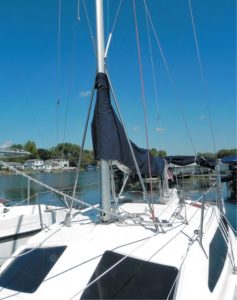
With just a forestay and two shrouds, the B&R rig relies on two sets of diamond stays and solid struts at deck level to keep the mast in column.
The 260’s mainsail is a combination of full and partial battens. Hunter 260s came with lazy jacks as standard equipment, but Bill presently does not use them. Blown Away’s headsail is a roller-furled 110-percent jib that tacks with ease. Most lines are led aft to the cabintop winches. It’s nice having no backstay to dodge while at the helm.
Deck
To gain a roomy cabin, Hunter chose a flush deck and high topsides. The deck is wide and easy to move on with good non-skid. A downside is that there is little to hold onto while moving forward, so one usually grabs for the shrouds. In the case of the 260, the mast-raising system’s struts, which stabilize the mast while it is raised and lowered and stiffens the mast under sail, also make for great grab rails.
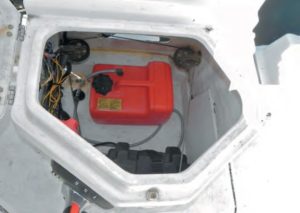
Fuel tank storage and access to the steering cables are provided beneath the helm seat in the wheel-steered version.
At the bow is a shallow anchor locker (some have a pit so the anchor is vertical) and many have an anchor roller. Both boats have plentiful large windows about the cabin for great interior light and views out. But there is only a single opening port over the galley and another in the head.
The cockpit is wide and comfortable, with plenty of room for entertaining. Early models had a cockpit table. There is a shallow fender locker under the port seat and another under the starboard seat. Small cubbies in the forward corners have drink holders. As the transom is open, there is no need for cockpit drains, but one needs to keep an eye on anything on the cockpit floor as it could soon be overboard. If there were following seas, it would be wise to put in the companionway drop boards as there is no bridge deck.
Accommodations
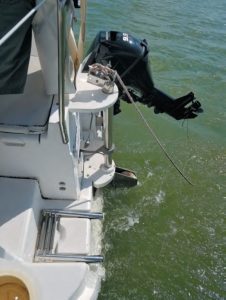
There is a little passage to the short swim step at the stern. The built-in folding ladder can be accessed from the water, safely away from the outboard motor.
Passage from the cockpit to belowdecks is through a wide, low companionway. The sliding hatch is a translucent smoked acrylic that on the 260 is protected by a sea hood. Two steps down and you are in a spacious cabin with the head immediately to port. Under the bottom step is access to the valve and vent for the 2,000-pound water ballast tank that runs the length of the boat. There is near-standing headroom for a 5-foot 10-inch person throughout the cabin except at the galley and head, where there is a bit more.
The saloon is exceptionally generous for lounging and entertaining. The table mounted on the mast compression post can be spun around to make a longer V-berth. It appears that the table could be lowered to form a very large berth, but the owner’s manual does not indicate this is possible, although there are receiving notches in the furniture pan. As have many owners, Bill cut a foot off the table to help in moving about the cabin; it is still a large table.
Aft, under the cockpit, is an extra-large berth that looks like it could sleep four if one could resolve the problem of humans getting in and out of it; it is meant to accommodate two sleepers athwartship.
The galley is quite usable for a 26-foot boat. The cook can stand at the counter without bending and prepare the meal on the one-burner butane stove (alcohol two-burner on the 26) and has easy access to the ice chest below a hinged section of the counter. On the 26, drains lead to simple above-the-waterline through-hulls, while the 260 has below-waterline through-hulls with valves.
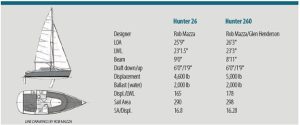
Personally, as a trailer-sailor, I am in love with the head on both of these models. Located to port at the bottom of the companionway steps, the head provides room to stand inside with the handsome curved door closed. Most will be found with a portable toilet, however Bill upgraded Blown Away to a marine head. In the back corner of the head is a fair-sized hanging locker and access to plumbing.
Underway
Our August test sail, with local sailing legend Ralph Immell aboard to lend a hand, found us with perfect conditions on lovely Lake Mendota.
Shortly after hopping off my pontoon/photo boat onto Blown Away, I was at the helm and astonished at the delicious feel of her wheel, despite it moving the outboard as well. As we bore off on a beam reach in winds of 6-8 knots, she barely needed any attention. When the wheel did need attention, it was only the lightest of touches.
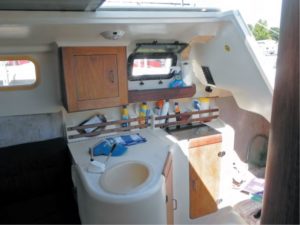
The molded galley module incorporates space for a stovetop, small sink, and manual water pump; a foot pump would be a worthwhile upgrade.
Consequently, one could steer from about anywhere. Sitting directly behind the wheel was quite comfortable with the Lifesling pack serving as a cushion. One can even sit up in the stern pulpit seats and still reach the wheel with a foot to give it the occasional nudge. Tiller-steered Hunter 260s and 26s are often steered from these optional seats. Visibility was good.
The mainsheet tackle is attached to the cockpit floor, a leftover arrangement from the tiller-steered boats. This is all but inaccessible to the helm of a wheel-steered boat. As water-ballasted boats are sensitive to gusts and can round up, it’s important to be able to depower the mainsail quickly. The best solution is to reef early.
With crew, standing in the companionway to handle jib sheets is the way to go. Both sides are within easy reach. In any case, the Hunter 260 comes about very quickly with little fuss and handles nicely off the wind as well.
The cockpit seats are quite comfortable with good width and chamfered backs that take the pain out of heeling. However, they are too far apart for bracing one’s feet, so there is a small heel ridge aft of the mainsheet attachment for staying in place. I would rig up something a bit taller running full length of the footwell.

Because securing a portable ice chest on small boats is often a problem, on the 260 there is a dedicated built-in place to keep one that is handy to the galley.
I rate the cockpit seats a 4.5 on the Penticoff Napability Index (PNI) scale of 1-5. They would be a perfect 5 except they are a tad short for me. Lounging against the bulkhead also makes for comfortable seating. While the boat heeled, even below I found it easy to move about, using the galley sink as a handhold.
Bill has had Blown Away out in 40-knot winds. Though the ride was wild, the water ballast kept her up and stable. On the other hand, while motoring, the offset outboard caused the handling to be peculiar, so Bill fabricated a stainless steel rod to connect it to the rudder, which doesn’t seem to affect handling under sail. Now the 9.9-horsepower Mercury four-stroke steers with the wheel while the engine controls are at hand on the helm seat. While I did not get a chance to steer under power, I would expect excellent low-speed handling qualities, although Bill says it gets a bit squirrelly at high speed.
Conclusion
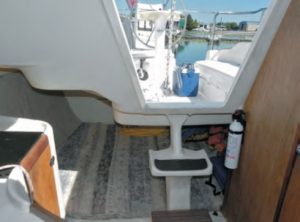
The cavernous area under the cockpit is billed as a double berth, though for many owners it’s storage for miscellaneous gear. An interesting feature is that this area is ventilated and illuminated by a small opening port under the starboard cockpit seat as long as the seat is up.
All in all, the Hunter 260 is a trailer-sailor’s dream. It is comfortable and handles like a sport boat. Hunter sold these boats as ready-to-sail packages for the novice, complete with a thorough 106-page owner’s manual that is still available online. The boat’s bareness, however, invites upgrades and customization.
The absence of wood makes it easy to maintain. As a trailerable boat with a clever mast-raising system, it is big. It may be more work than some owners will want to do before upside is that faraway cruising destinations are only a few road hours to endure.
Check to see if you need a permit for the 9-foot beam, as 8 feet 6 inches is usually the maximum allowed. If you want to trailer often, you might look at the Hunter 23.5 or the Hunter 240 (beam 8 feet 3 inches), which are smaller versions of the 26/260 with similar features, including water ballast, and hard to discern as different.
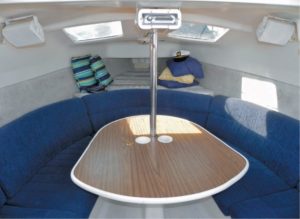
Some owners have modified the large table to be smaller to ease access fore and aft.
The Hunter 26/260s are very popular. Online I found many for sale, but prices are all over the place. Low was $10,450 for a 1996 26, with a high of $32,000 for a 2004 260. Generally, the 26s are in the low teens, while the 260s are mid-teens to low 20s. Because they are trailerable, give preference to freshwater boats, of which there are plenty. One should confirm there is a two-axle trailer with the boat if you intend to move it via land. Most seem to come equipped with a 9.9-horsepower outboard.
As for various maintenance problems, leaky windows will likely be the main troublemakers. There were some issues with 260 rudders cracking in the 2004 models. It appears this was a short-term build issue that Hunter resolved, sending updated rudders to owners. Foss Foam can provide “as original” fiberglass rudders, while Rudder Craft provides HDPE aftermarket replacements.
Good Old Boat Contributing Editor Allen Penticoff is a freelance writer, sailor, and longtime aviator. He has trailer-sailed on every Great Lake and on many other inland waters and has had keelboat adventures on fresh and saltwater. He owns an American 14.5, a MacGregor 26D, and a 1955 Beister 42-foot steel cutter that he stores as a “someday project.”
Thank you to Sailrite Enterprises, Inc., for providing free access to back issues of Good Old Boat through intellectual property rights. Sailrite.com

